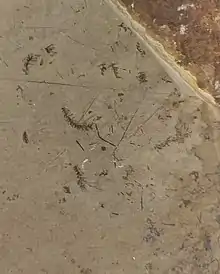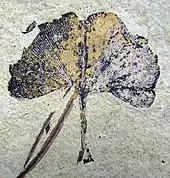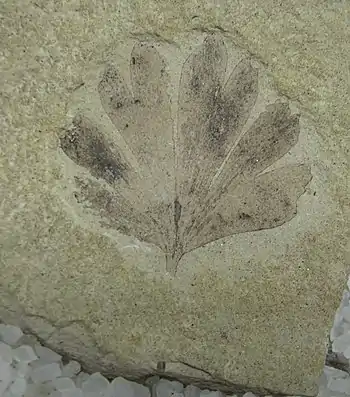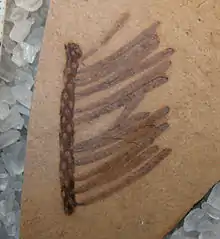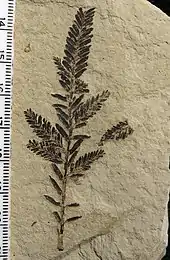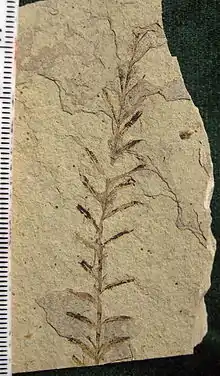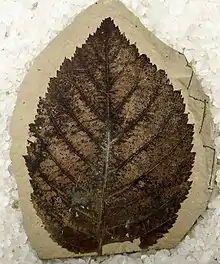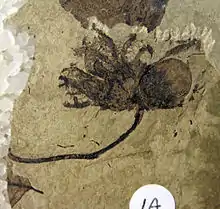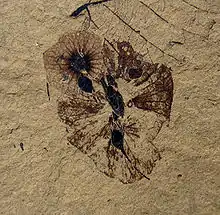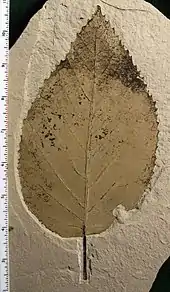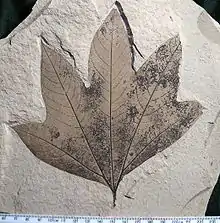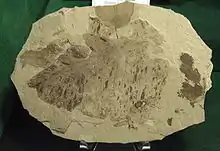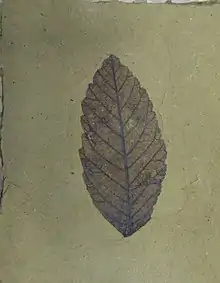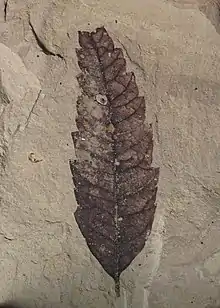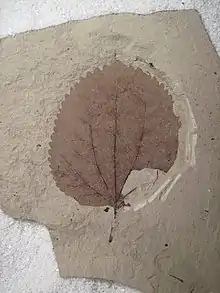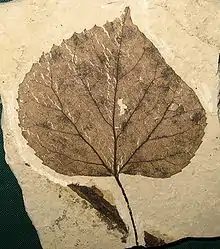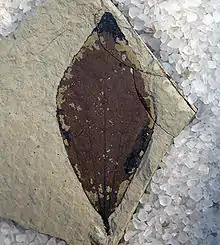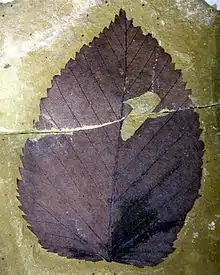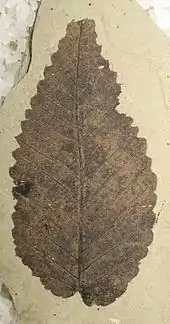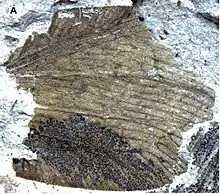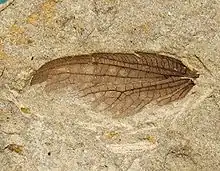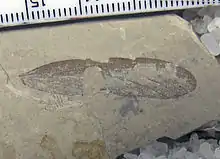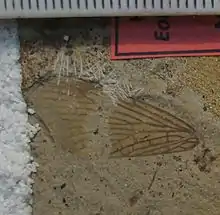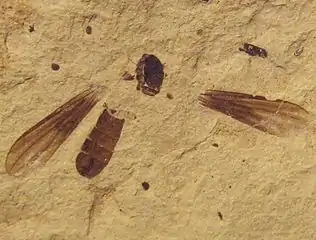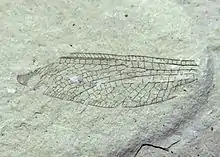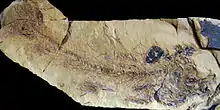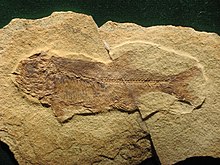Klondike Mountain Formation
The Klondike Mountain Formation is an Early Eocene (Ypresian) geological formation located in the northeast central area of Washington state. The formation, named for the type location designated in 1962, Klondike Mountain north of Republic, Washington, is composed of volcanic rocks in the upper unit and volcanics plus lacustrine (lakebed) sedimentation in which a lagerstätte with exceptionally well-preserved plant and insect fossils has been found, along with fossil epithermal hot springs.
| Klondike Mountain Formation Stratigraphic range: Ypresian 50.1–48.9 Ma | |
|---|---|
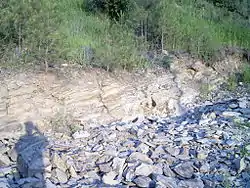 Klondike Mountain Formation outcrop at site A0307 | |
| Type | Geological formation |
| Unit of | Okanagan Highlands |
| Sub-units | Tom Thumb Tuff, Lower & Upper Members |
| Underlies | Glacial deposits |
| Overlies | Sanpoil Volcanics & others |
| Thickness | up to 3,200 ft (980 m) |
| Lithology | |
| Primary | Variable |
| Other | See text |
| Location | |
| Coordinates | 48.7°N 118.7°W |
| Approximate paleocoordinates | 54.4°N 101.9°W |
| Region | Okanagan highlands |
| Country | |
| Extent | Okanagan highlands |
| Type section | |
| Named for | Klondike Mountain |
| Named by | Muessig |
| Year defined | 1962 |
 Klondike Mountain Formation (the United States)  Klondike Mountain Formation (Washington (state)) | |
The formation is the youngest in a group of formations which belong to the Challis Sequence rocks. The formation unconformably overlies rocks of the Eocene Sanpoil Volcanics and much older Triassic and Permian formations. The formation is bounded on its edges by a series of high-angle strike slip faults, which have contained the Klondike Mountain Formation in a series of graben structures, such as the Republic Graben. Public access to a fossilifrous outcrop at the north end of Republic is mediated by the nonprofit Stonerose Interpretive Center.
Extent
The formation is located in northern Ferry County, Washington, with the majority of the sedimentation in the Republic and Curlew Basins on the east and in the Toroda Creek area to the north west. The town of Republic, Washington is situated at the southern end of the formation, with outcrops within the city itself. The formation was named for Klondike Mountain which is just to the northeast of the city, and where the type locality is located.[1] The Curlew basin is situated north of Republic, with the northern edge along the Kettle River and the community of Curlew, Washington near the northeastern edge.[2][3]
The formation is the southernmost of a string of preserved Eocene highland lakebeds in Washington state and British Columbia.[4] The lake system, within the Okanagan highlands, extends from the Klondike Mountain Formation north approximately 1,000 kilometres (1,000,000 m) in to southern central British Columbia.[5]
Age
Early dating of the formation was based primarily on identification and correlation of the fossils found in the Tom Thumb Tuff, with Joseph Umpleby (1910) reporting a putative age of Early Miocene.[6] This date was based in examination of fossils by C. R. Eastman, who thought them to be similar to those found in the Florissant Formation of Colorado, which at the time was also considered Miocene. This age was retained by Edward W. Berry (1929), who included the Klondike Mountain Formation fossil lakebeds as part of the Latah Formation.[7] The age of the Formation has been revised in the following hundred years, with Roland W. Brown (1936) identifying the deposits as being older than the Latah Formation.[8] In a later written communication circa 1958, Brown again revised the age still older, stating the fossils found in the area of Mount Elizabeth indicated an Oligocene age. This age was used by R.L. Parker and J. A. Calkins in their 1964 work on the Curlew Quadrangle of Ferry County.[9] Since then the fossil-bearing strata of the Formation have been radiometrically dated, to give a current estimate of the Ypresian, the mid stage of the early Eocene,49.4 ± .5 million years ago.[5]
Lithology
Parker and Calkins in 1964 noted the association of the Klondike Mountain Formation with the gold and silver deposits of the Republic District and suggested it as a potential host to more ore deposits in the Curlew Quadrangle.[9] The epithermal gold deposits occurring in the Sanpoil volcanics terminate directly below the unconformity where the volcanics contact the base of the Klondike Mountain Formation[10] or sometimes penetrate into the Formation's lowest unit.[11] Hydrothermal sinter deposits are known from the lowest portions of the Formation and are thought to represent hydrothermal eruption areas.[11] In general the lower portions of the Formation have a large amount of hydrothermal alteration, and areas around vents are rich in pyrite and silica. two products of natural hydrothermic sintering. The areas above that show a transition to mudstones, siltstones and sandstones grading from fine-grained material into coarser materials moving up the strata column. The finely-bedded stones show the greatest numbers of fossils and the finest preservation of details.[12]
Paleoenvironment and paleoclimate
The lake bed sediments preserve a diverse array of plants, insects, and fishes, notably the biota called the Republic flora. The Okanagan lake system, which includes the Klondike Mountain Formation, has been classified as one of the great Canadian lagerstätten.[13] The area likely had a mesic upper microthermal to lower mesothermal climate, in which winter temperatures rarely dropped low enough for snow, and which were seasonably equitable.[14]
The Okanagan highlands paleoforest surrounding the lakes have been described as precursors the to modern Temperate broadleaf and mixed forests of Eastern North America and Eastern Asia. Based on the fossil biotas the lakes were higher and cooler then the coeval coastal forests preserved in the Puget Group and Chuckanut Formation of Western Washington, which are described as lowland tropical forest ecosystems. Estimates of the paleoelevation between 0.7–1.2 km (0.43–0.75 mi) higher than the coastal forests. This is consistent with the paleoelevation estimates for the lake systems, which range between 1.1–2.9 km (1,100–2,900 m), which is similar to the modern elevation 0.8 km (0.50 mi), but higher.[14]
Estimates of the mean annual temperature have been derived from Climate leaf analysis multivariate program (CLAMP) and leaf margin analysis (LMA) of the Republic paleoflora. The CLAMP results after multiple linear regressions for Republic gave a mean annual temperature of approximately 8.0 °C (46.4 °F), while the LMA gave 9.2 ± 2.0 °C (48.6 ± 3.6 °F). This is lower then the mean annual temperature estimates given for the coastal Puget Group, which is estimated to have been between 15–18.6 °C (59.0–65.5 °F). The bioclimactic analysis for Republic suggests a mean annual precipitation amount of 115 ± 39 cm (45 ± 15 in).[14]
Pteridophytes
| Name | Authority | Year | Family | Notes | Images |
|---|---|---|---|---|---|
|
Arnold, 1955 |
1955 |
| |||
Pinophytes
| Name | Authority | Year | Family | Notes | Images |
|---|---|---|---|---|---|
|
Shorn & Wehr, 1986 |
1986 |
Oldest true fir described |
| ||
|
Amentotaxus sp.[18] |
Schorn & Wehr |
1996 |
A yew |
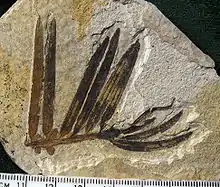 Amentotaxus sp. | |
|
Cephalotaxus sp.[18] |
Schorn & Wehr |
1996 |
A yew |
||
|
Schorn & Wehr |
1996 |
A false cypress |
|||
|
Cryptomeria sp.[18] |
Schorn & Wehr |
1996 |
A sugi |
||
|
Schorn & Wehr |
1996 |
A Chinese swamp cypress |
|||
|
1987 |
| ||||
|
Schorn & Wehr |
1996 |
A spruce |
|||
|
Pinus latahensis[7] |
Berry, 1929 |
1929 |
A 5 needle pine |
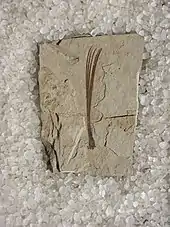 Pinus latahensis | |
|
"Pinus macrophylla"[7] |
Berry, 1929 |
1929 |
A 3 needle pine, jr homoym to Pinus macrophylla Lindley 1839 |
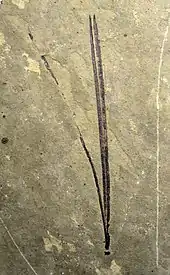 "Pinus macrophylla" | |
|
Pinus monticolensis[7] |
Berry, 1929 |
1929 |
A pine seed morphogenus |
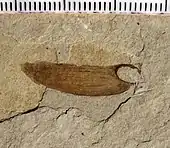 Pinus monticolensis | |
|
Pinus tetrafolia[7] |
Berry, 1929 |
1929 |
A possible 4 needled pine, |
||
|
Pseudolarix wehrii[21] |
Gooch, 1992 |
1940 |
A golden larch, |
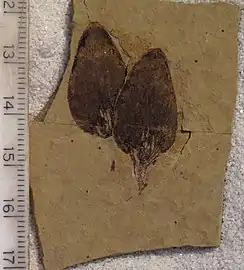 Pseudolarix wehrii | |
|
1935 |
A coast redwood, |
| |||
|
(Sternberg) Heer, 1855 |
1929 |
||||
|
Schorn & Wehr |
1996 |
A yew |
|||
|
Schorn & Wehr |
1996 |
An arborvitae |
|||
|
(Knowlton) LaMotte, 1926 |
1929 |
A plum-yew relative |
|||
|
Schorn & Wehr |
1996 |
A hemlock |
|||
Flowering plants
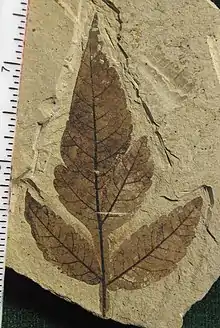
Over a dozen different Rosaceae genera, both extant and extinct, have been identified in the formation. These fossils are some of the oldest reliable macrofossils (excluding ancient fossil pollen) for the family.[23] Fossils of Sorbus genus and Rhus genus leaves that show evidence of being interspecies hybrids have been noted from the formation. Flynn, DeVore and Pigg in 2019 described four species of sumac which formed multiple hybrids.[24] Between three and four Trochodendraceae species that have been described from the Klondike Mountain Formation. Broadly circumscribed four species in three genera have been identified at Republic, Paraconcavistylon wehrii, Pentacentron sternhartae, Tetracentron hopkinsii, and Trochodendron nastae. Additionally the species Trochodendron drachukii is known from related Kamloops group shales at the McAbee Fossil Beds near Cache Creek, British Columbia. Manchester et al. 2018 noted that Tr. drachukii is likely the fruits of Tr. nastae, while Pe. sternhartae are likely the fruits of Te. hopkinsii.[25] If fossils of the fruits and foliage in attachment are found, that would bring the species count down to three whole plant taxa.[25] Additionally, the extinct genus Nordenskioldia is also known from the formation. The placement of Nordenskioldia is debated, with some treatments placing it into Trochodendraceae, while a 2020 analysis placed it outside of the crown-group Trochodendaceae.[26] Wesley Wehr in 1994 reported Bignoniaceae seeds along with a single Rubiaceae fruit and an isolated Fabaceae leaf.[27] An update of the floral list by Wehr and Manchester published in 1996 added an additional fifteen taxa identified from reproductive structures such as flowers fruits or seeds.[28] One of the fossils illustrated was tentatively identified as from the banana genus Ensete while another was placed in the extinct myrtle genus Paleomyrtinaea. However further fossil finds resulted in the re-identification of the first as a rhizome section likely from the water-lily Nuphar carlquistii, while the second is a seed mass from the same water-lilly.[29]
| Name | Authors | Year | Family | Notes | Images |
|---|---|---|---|---|---|
|
Acer arcticum[30] |
Heer, 1876 |
1987 |
A maple |
||
|
Wolfe & Tanai, 1987 |
1987 |
A maple |
|||
|
Wolfe & Tanai, 1987 |
1987 |
A maple |
|||
|
Acer spitzi[30] |
Wolfe & Tanai, 1987 |
1987 |
A maple |
||
|
Wolfe & Tanai, 1987 |
1987 |
A maple |
|||
|
Wolfe & Tanai, 1987 |
1987 |
A maple |
|||
|
Wolfe & Tanai, 1987 |
1987 |
A maple |
|||
|
Acer wehri[30] |
Wolfe & Tanai, 1987 |
1987 |
A maple |
||
|
Alnus parvifolia[20] |
(Berry) Wolfe & Wehr, 1929 |
1929 |
An Alder |
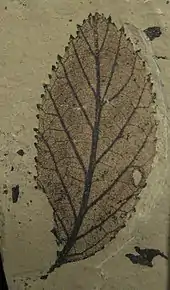 Alnus parvifolia | |
|
Barghoornia oblongifolia[20] |
Wolfe & Wehr, 1987 |
1987 |
An extinct Bursera relative |
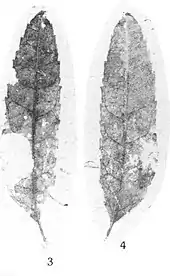 Barghoornia oblongifolia | |
|
Wolfe & Wehr, 1987 |
1987 |
A birch |
| ||
|
Bohlenia americana[20] |
(Brown) Wolf & Wehr, 1935 |
1935 |
An extinct sapindale |
 Bohlenia americana | |
|
Calycites ardtunensis[27] |
Crane, 1988 |
1995 |
A winged fruit of unidentified affinities |
||
|
Calycocarpum sp.[28] |
(Nuttall) Spach, 1839 |
1996 |
A moonseed |
||
|
Carpinus perryae[31] |
Pigg, Manchester, & Wehr, 2003 |
2003 |
Betulaceae |
A hornbeam |
|
|
Cedrelospermum sp.[28] |
Saporta, 1889 |
1996 |
An elm relative |
||
|
Cercidiphyllum obtritum[20] |
(Dawson) Wolfe & Wehr, 1890 |
1935 |
A katsura |
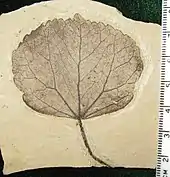 Cercidiphyllum obtritum | |
|
Comptonia columbiana[20] |
Dawson, 1890 |
1890 |
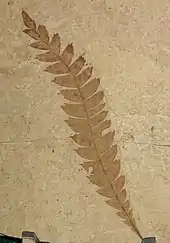 Comptonia columbiana | ||
|
Radtke, Pigg, & Wehr, 2001 |
2001 |
||||
|
Pigg, Manchester, & Wehr, 2003 |
2003 |
Betulaceae |
| ||
|
Wehr, 1995 |
1995 |
A Cragia species |
|||
|
Cruciptera simsonii[33] |
(Brown) Manchester |
1991 |
A walnut family relative. |
||
|
Deviacer sp.[27] |
Wehr, 1995 |
A milkwort relative |
|||
|
Manchester & Pigg, 2008 |
2008 |
A flower of unknown relationships |
| ||
|
Dipteronia brownii[35] |
McClain & Machester, 2001 |
2001 |
Sapindaceae |
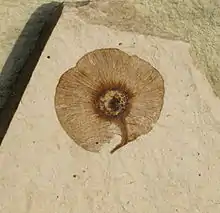 Dipteronia brownii | |
|
Brown, 1940 |
1997 |
A "hard rubber tree" |
| ||
|
Fagopsis undulata[20] |
1987 |
A beech |
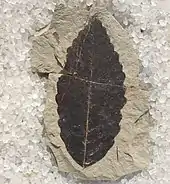 Fagopsis undulata | ||
|
Fagus langevinii[37] |
Manchester & Dillhoff, 2004 |
2004 |
A beech |
||
|
(Mathewes & Brooke) Manchester |
A chocolate relative |
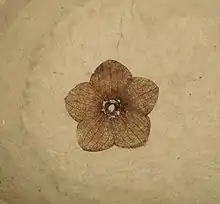 Florissantia quilchenensis | |||
|
Radtke, Pigg, & Wehr, 2005 |
2005 |
Hamamelidaceae |
| ||
|
Koelreuteria dilcheri[38] |
Wang et al., 2012 |
2012 |
A Koelreuteria species |
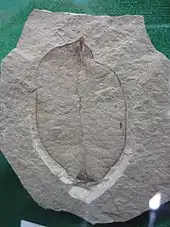 Koelreuteria dilcheri | |
|
Wolfe & Wehr, 1987 |
1987 |
A witch hazel relative |
| ||
|
Macginicarpa sp.[27] |
Manchester, 1986 |
1995 |
A plane tree |
||
|
(Lesquereux) Wolfe & Wehr |
1929 |
| |||
|
Colebrook, 1819 |
1996 |
A Meliosma species |
|||
|
Nordenskioldia sp.[27] |
Wehr, 1995 |
1995 |
A trochodendroid of uncertain placement. |
||
|
DeVore, Taylor, & Pigg, 2015 |
2015 |
A waterlily, |
 Nuphar carlquistii seeds | ||
|
Oemleria janhartfordae[23] |
Benedict, DeVore, & Pigg, 2011 |
2011 |
An Osoberry |
||
|
Bogner, Johnson, Kvaček & Upchurch, 2007 |
2007 |
Araceae |
| ||
|
Palaeocarpinus barksdaleae[31] |
Pigg, Manchester, & Wehr, 2003 |
2003 |
Betulaceae |
A birch relative |
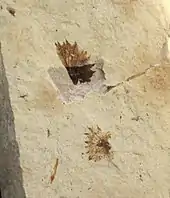 Palaeocarpinus barksdaleae |
|
Paleoallium billgenseli[40] |
Pigg, Bryan, & DeVore, 2018 |
2018 |
An onion relative |
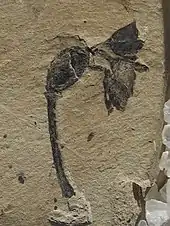 Paleoallium billgenseli | |
|
Palaeophytocrene sp.[27] |
Wehr, 1995 |
1995 |
A Phytocrene relative |
||
|
(Manchester et al., 2018) |
2018 |
A Trochodendrale first described as "Concavistylon" wehrii |
|||
|
Manchester et al., 2018 |
2018 |
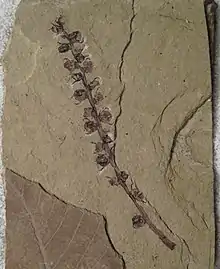 Pentacentron sternhartae | |||
|
Photinia pageae[20] |
Wolfe & Wehr, 1987 |
1987 |
Rosacaea |
A Christmas-berry relative |
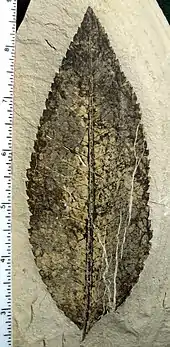 Photinia pagae |
|
Plafkeria sp.[27] |
Wehr, 1995 |
1995 |
A linden relative |
||
|
Platananthus[41] |
Pigg & Wehr, 2002 |
2002 |
A sycamore stamen head |
||
|
Populus lindgreni[7] |
Knowlton, 1898 |
1929 |
|||
|
Prunus cathybrownae[23] |
Benedict, DeVore, & Pigg, 2011 |
2011 |
A cherry relative |
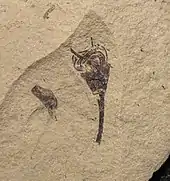 Prunus cathybrownae | |
|
Pterocarya sp.[27] |
Wehr, 1995 |
1995 |
A wing nut |
||
|
Pigg & Wehr, 2002 |
2002 |
A cannabaceous fruit |
|||
|
Pteronepelys wehrii[42] |
Manchester |
1994 |
A samara of uncertain affinities. |
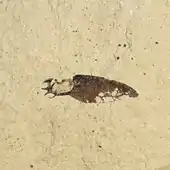 Pteronepelys wehrii | |
|
Wehr, 1995 |
1995 |
An oak |
|||
|
Republica hickeyi[20] |
Wolfe & Wehr, 1987 |
1987 |
incertae seids |
An incertae sedis angiosperm |
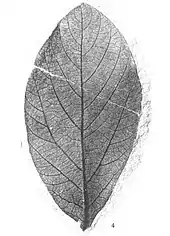 Republica hickeyi |
|
Flynn, DeVore, & Pigg, 2019 |
2019 |
A sumac, |
| ||
|
Flynn, DeVore, & Pigg, 2019 |
2019 |
A sumac, |
| ||
|
(Wolfe and Wehr) Flynn, DeVore and Pigg |
1987 |
A sumac, |
| ||
|
Flynn, DeVore, & Pigg, 2019 |
2019 |
A sumac, |
|||
|
Sabia sp.[28] |
Colebrook, 1819 |
1996 |
A Sabia species |
||
|
Berry, 1929 |
1929 |
| |||
|
Schoepfia republicensis[20] |
(LaMotte) Wolfe & Wehr, 1944 |
1929 |
A Schoepfia relative |
 Schoepfia republicensis | |
|
Pigg & Wehr, 2002 |
2002 |
An elaeocarpaceous fruit |
|||
|
Pigg et al., 2007 |
2018 |
A Trochodendrale, |
| ||
|
Wolfe & Wehr, 1987 |
1987 |
Malvaceae |
A Linden |
| |
|
Pigg, Wehr, & Ickert-Bond, 2001 |
2001 |
| |||
|
Wolfe & Wehr, 1987 |
1987 |
A dove-tree relative |
| ||
|
Ulmus chuchuanus[44] |
(Berry) LaMotte, 1926 |
2005 |
An elm species |
||
|
Denk & Dillhoff, 2005 |
2005 |
An elm species |
| ||
|
Wehr, 1995 |
1995 |
A grape |
|||
Arthropods
The insect fauna of the Klondike Mountain Formation includes representatives from over 13 orders, based on a 1992 estimate, including immature though adult specimens and both terrestrial and aquatic taxa.[45] The most prevalent orders are Diptera and Hemiptera, each making up approximately 30% of the fossil insects known in 1992. A solitary lepidopteran fossil has been recovered, but no full descriptive work has been made on the specimen, aside from a single PhD dissertation. Early examination placed the moth in the family Geometridae, but later work has identified it as the oldest member of the tiger moth subfamily Arctiinae.[46]
The neuropteran insects (lacewings and their allies) identified as of 2014 include species from the families Berothidae, Chrysopidae, Hemerobiidae, Ithonidae (including Polystoechotidae), Nymphidae, Osmylidae, and Psychopsidae.[5] A number of mecopteran species belonging to the families Cimbrophlebiidae, Dinopanorpidae, Eorpidae, and Panorpidae are also known.[47] Fossil wings first described in 2015 were identified as being from Susumanioidea stick-insects, a group that had been known from the Jurassic to the Paleocene only.[48] The order Dermaptera was first reported in 1992[45] and is known from a series of isolated partial specimens, mostly abdominal sections with the distinct anal forceps attached. Based on the forceps structuring the specimens were tentatively assigned to the modern family Forficulidae, as the oldest North American representatives of the family known at that time.[49] A list of Coleopteran families identified by 1992 included Carabidae, Cerambycidae, Chrysomelidae, Curculionidae, Dytiscidae, Elateridae and Lucanidae,[45] but the beetle fauna has not been described in depth yet, with only two weevil species having been fully described.[50][51] A review of the Okanagan highlands hymenoptera published in 2018 identified four "Symphyta" families in the formation Cimbicidae, Pamphiliidae, Siricidae, and Tenthredinidae. Of the "Apocrita" families thirteen are represented, the "Parasitica" families are Braconidae, Diapriidae Ichneumonidae, Proctotrupidae, and Roproniidae while the Vespodea families are Formicidae, Pompilidae, Scoliidae and Vespidae. Within Apoidea the "Spheciformes" families include Angarosphecidae and Sphecidae while Halictidae is the sole "Apiformes" family known from body fossils. Prunus and Ulmus leaves have been found having damage that is consistent with the damage pattern left by Megachilidae species bees when they remove sections of tissue for nest lining. There are several additional Apoidea fossils that were left as incertae sedis in the group based on the similarity between them and Paleorhopalosoma menatensis, a Paleocene species described from the Menat Formation Auvergne, France. The placement of P. menatensis is uncertain, having been initially described as a member of Rhopalosomatidae, but is possibly an Angarosphecidae or closely related taxon,based on the wing and body morphology.[52]
| Name | Authors | Year | Family | Notes | Images |
|---|---|---|---|---|---|
|
Adamsochrysa wilsoni[53] |
Makarkin & Archibald |
2013 |
A green lacewing |
||
|
Makarkin & Archibald |
2014 |
A possible psychopsid lacewing |
| ||
|
Makarkin & Archibald |
2009 |
| |||
|
Antiquiala snyderae[55] |
Archibald & Cannings |
2019 |
|||
|
Aphrophora sp.[45] |
Lewis, 1992 |
1992 |
An aphrophorid spittlebug |
||
|
Cimbrophlebia brooksi[47] |
Archibald |
2009 |
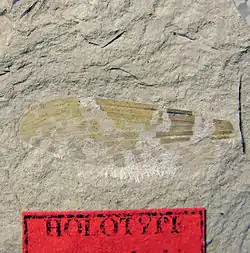 Cimbrophlebia brooksi | ||
|
Cimbrophlebia westae[47] |
Archibald |
2009 |
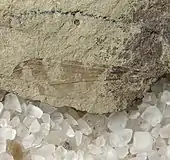 Cimbrophlebia westae | ||
|
Archibald |
2005 |
A scorpion fly species |
| ||
|
Archibald |
2005 |
A scorpion fly species |
|||
|
Archibald |
2005 |
A scorpion fly species |
|||
|
Eoceneithycerus carpenteri[50] |
Legalov |
2013 |
|||
|
Archibald & Bradler |
2015 |
Susumanioidea |
A stick insect species |
||
|
Archibald, Mathewes, & Greenwood |
2013 |
A mecopteran scorpionfly |
| ||
|
Archibald, Mathewes, & Greenwood |
2013 |
A mecopteran scorpionfly, tentatively identified |
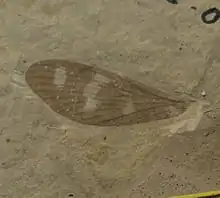 Possible E. ypsipeda[57] | ||
|
Ithyceroides klondikensis[51] |
Legalov |
2015 |
|||
|
Idemlinea versatilis[55] |
Archibald & Cannings |
2019 |
|||
|
Klondikia whiteae[58] |
Dlussky & Rasnitsyn |
2003 |
An ant |
||
|
Archibald, Kehlmaier, & Mathewes |
2014 |
| |||
|
Archibald, Cover, & Moreau |
2006 |
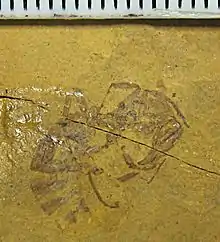 Myrmeciities sp. | |||
|
Sinitchenkova |
1999 |
A mayfly |
|||
|
Archibald, Makarkin, & Ansorge |
2009 |
| |||
|
Oecophylla kraussei[63] |
(Dlussky & Rasnitsyn) |
1999 |
An ant, described as Camponotites kraussei, |
||
|
Palaeopsychops marringerae[65] |
Archibald & Makarkin, 2006 |
2006 |
A giant lacewing |
 Palaeopsychops marringerae | |
|
Palaeopsychops timmi[65] |
Archibald & Makarkin, 2006 |
2006 |
A giant lacewing |
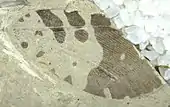 Palaeopsychops timmi | |
|
Palecphora sp.[45] |
Lewis, 1992 |
1992 |
A cercopid froghopper |
||
|
Petrolystra sp.[45] |
Lewis, 1992 |
1992 |
An aphrophorid spittlebug |
||
|
Polystoechotites barksdalae[60] |
Archibald & Makarkin, 2006 |
2006 |
A giant lacewing |
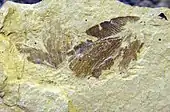 Polystoechotites barksdalae | |
|
Polystoechotites falcatus[60] |
Archibald & Makarkin, 2006 |
2006 |
A giant lacewing |
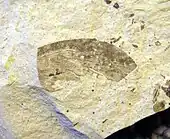 Polystoechotites falcatus | |
|
Polystoechotites lewisi[60] |
Archibald & Makarkin, 2006 |
2006 |
A giant lacewing |
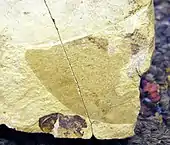 Polystoechotites lewisi | |
|
Makarkin, Archibald, & Oswald |
2003 |
A hemerobiid lacewing, originally placed in Cretomerobius, |
|||
|
Propalosoma gutierrezae[63] |
Dlussky & Rasnitsyn |
1999 |
An ant, described as a Rhopalosomatidae wasp, |
 Propalosoma gutierrezae | |
|
Archibald & Rasnitsyn |
2015 |
A parasitic wasp |
|||
|
Ypshna brownleei[55] |
Archibald & Cannings |
2019 |
|||
|
"Forficulid species 1"[49] |
Lewis, 1994 |
1994 |
A possible forficulid earwig with long cerci |
||
|
"Forficulid species 2"[49] |
Lewis, 1994 |
1994 |
A possible forficulid earwig with short cerci |
||
Vertebrates
Five species of fish have been identified from the formation, four of which are known from skeletal elements, while the fifth is only known from isolated scales.[71] Of the five species, two are unique to the formation, Hiodon woodruffi and Libotonius pearsoni were both described by paleoichthyologist Mark V. H. Wilson in 1978 and 1979 respectively. The other three species, "Amia" hesperia, Amyzon aggregatum, and Eosalmo driftwoodensis, were first described from Okanagan Highlands formations in British Columbia and subsequently also identified from Ferry County fossils. The first notation of fish fossils in the Republic area was by Joseph Umpleby in his 1910 visit to the area, who collected fish near the Tom Thumb Mine, and sent them to the National Museum of Natural History. After examining the fossils, Charles R. Eastman listed the specimens as belonging to the extinct species Amyzon brevipinne in his Fossil fishes in the collection of the United States National Museum.[72] Research tapered off until a series of fish were collected in the Toroda Creek Graben northwest of Republic by R. C. Pearson during his compilation of the Geologic map of the Bodie Mountain quadrangle, Ferry and Okanogan Counties, Washington. The fossils were tentatively identified by paleoichthyologist David Dunkle as members of the genera Amyzon, Tricophanes, Erismatopterus and an undefined salmonid.[73] Pearson sent almost all of the specimens collected to the Smithsonian, but the fossils were never accessioned into the collections there and are now considered lost. He did retain one fossil from the initial collection which was later donated to the USGS collections. The largest single work on the fish of the Okanagan Highlands was published by Mark Wilson in 1977 and covered fossils collected from the known British Columbian Okanagan Highlands fossil sites of the time.[74] While not covering the Washington State fossils, Wilson named two of the species that are currently recognized from the Klondike Mountain Formation Amyzon aggregatum and Eosalmo driftwoodensis. Additionally scales attributed to the genus Amia were discussed and the genus Libotonius was named from fossils in the Allenby Formation.[75][76] In the late 1960s a collection of fish from near the Tom Thumb Mine in Republic was compiled by resident R. Woodward. During the summers of 1976 and 1977 the University of Alberta conducted field collecting in both the Republic and Toroda Creek areas, along with the donation of the Woodward collection, yielded a number of fossil catostomids, along with a single percopsid, a salmonid, a hiodontid, and an Amia scale. The hiodontids were subsequently described as the species Eohiodon woodruffi in 1978 based on differences between the Tom thumb Tuff fossils and those found in British Columbian sites.[73] A year later the percopsid fossils were also described as Libotonius pearsoni, extending the range of the genus south from the Allenby Formation.[75]
Bird fossils are limited to mostly isolated feathers that are preserved in the finer grained strata of the lake bed, though one partial bird skeleton has also been recovered.
| Name | Authors | Year | Family | Notes | Images |
|---|---|---|---|---|---|
|
"Amia" hesperia |
Wilson |
1977 |
A bowfin |
||
|
Wilson |
1977 |
A sucker |
 Amyzon aggregatum | ||
|
Wilson |
1977 |
A Salmon |
| ||
|
Wilson |
1978 |
| |||
|
Wilson |
1979 |
A sand roller relative. |
|||
|
"Unnamed"[78] |
Mayr et al. |
2019 |
Aves incertae sedis |
indeterminate feathers and a skeleton |
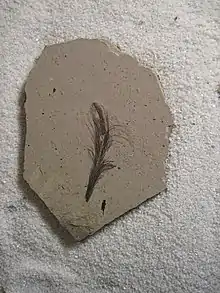 Unidentified feather |
References
- Muessig, Siegfried (1962). "Tertiary volcanic and related rocks of the Republic area, Ferry County, Washington". Geological Survey Research 1962. 450 D: D56–58.
- Gaylord, DR; Suydam, JD; Price, SM; Matthews, JM; Lindsey, KA (1996). "Depositional history of the uppermost Sanpoil Volcanics and Klondike Mountain Formation in the Republic basin". Washington Geology. 24 (2): 15–18.
- Cheney, ES; Rasmussen, MG (1996). "Regional geology of the Republic area". Washington Geology. 24 (2): 3–7.
- Suydam, J.; Gaylord, D.R. (1997). "Toroda Creek half graben, northeast Washington: Late-stage sedimentary infilling of a synextensional basin". Geological Society of America Bulletin. 109 (10): 1333–1348. Bibcode:1997GSAB..109.1333S. doi:10.1130/0016-7606(1997)109<1333:tchgnw>2.3.co;2.
- Makarkin, V.; Archibald, S.B. (2014). "An unusual new fossil genus probably belonging to the Psychopsidae (Neuroptera) from the Eocene Okanagan Highlands, western North America". Zootaxa. 3838 (3): 385–391. CiteSeerX 10.1.1.692.1185. doi:10.11646/zootaxa.3838.3.8. PMID 25081783.
- Umpleby, J. B. (1910). "Geology and ore deposits of Republic mining district". Washington Geological Survey. 1.
- Berry, E.W. (1929). "H - A revision of the flora of the Latah Formation". USGS Professional Paper Series (PDF). PP 154-H. pp. 225–265. doi:10.3133/pp154H https://pubs.usgs.gov/pp/0154h/report.pdf. Missing or empty
|title=(help) - Brown, R. W. (1937). "J - Additions to some fossil floras of the Western United States". Shorter contributions to general geology (PDF). 186. United States Geological Survey. pp. 163–206. doi:10.3133/pp186J.
- Parker, RL; Calkins, JA (1964). "Geology of the Curlew Quadrangle, Ferry County, Washington". Geological Survey Bulletin. 1169.
- Boleneus, DE; Raines, GL; Causey, JD; Bookstrom, AA; Frost, TP; Hyndman, PC (2001). "Assessment method for epithermal gold deposits in northeast Washington State using weights-of-evidence GIS modeling" (PDF). USGA Open File Report. 01–501: 1–52.
- Lasmanis, R (1996). "A historical perspective on ore formation concepts, Republic Mining District, Ferry County, Washington". Washington Geology. 24 (2): 8–11.
- Gaylord, DR; Price, SM; Suydam, JD (2001). Volcanic and hydrothermal influences on middle Eocene lacustrine sedimentary deposits. Republic Basin, northern Washington, USA. International Association of Sedimentologists Special Publication. pp. 199–222. ISBN 9781444304268.
- Archibald, S.; Greenwood, D.; Smith, R.; Mathewes, R.; Basinger, J. (2011). "Great Canadian Lagerstätten 1. Early Eocene Lagerstätten of the Okanagan Highlands (British Columbia and Washington State)". Geoscience Canada. 38 (4): 155–164.
- Greenwood, D.R.; Archibald, S.B.; Mathewes, R.W; Moss, P.T. (2005). "Fossil biotas from the Okanagan Highlands, southern British Columbia and northeastern Washington State: climates and ecosystems across an Eocene landscape". Canadian Journal of Earth Sciences. 42 (2): 167–185. Bibcode:2005CaJES..42..167G. doi:10.1139/e04-100.
- Arnold, C. A. (1955). "A Tertiary Azolla from British Columbia" (PDF). Contributions from the Museum of Paleontology, University of Michigan. 12 (4): 37–45.
- Mustoe, G.E. (2002). "Eocene Ginkgo leaf fossils from the Pacific Northwest". Canadian Journal of Botany. 80 (10): 1078–1087. doi:10.1139/b02-097.
- Schorn, Howard; Wehr, Wesley (1986). "Abies milleri, sp. nov., from the Middle Eocene Klondike Mountain Formation, Republic, Ferry County, Washington". Burke Museum Contributions in Anthropology and Natural History (1): 1–7.
- Schorn, H. E.; Wehr, W. C. (1996). "The conifer flora from the Eocene uplands at Republic, Washington". Washington Geology. 24 (2): 22–24.
- Chaney, R.W. (1951). "A revision of fossil Sequoia and Taxodium in western North America based on the recent discovery of Metasequoia". Transactions of the American Philosophical Society. 40 (3): 231.
- Wolfe, J.A.; Wehr, W.C. (1987). "Middle Eocene dicotyledonous plants from Republic, northeastern Washington". United States Geological Survey Bulletin. 1597: 1–25.
- Gooch, N. L. (1992). "Two new species of Pseudolarix Gordon (Pinaceae) from the middle Eocene of the Pacific Northwest". PaleoBios. 14: 13–19.
- LaMotte, R.S. (1944). "Supplement to catalogue of Mesozoic and Cenozoic plants of North America, 1919–37". United States Geological Survey Bulletin. 924: 307.
- Benedict, JC; DeVore, ML; Pigg, KB (2011). "Prunus and Oemleria (Rosaceae) Flowers from the Late Early Eocene Republic Flora of Northeastern Washington State, U.S.A.". International Journal of Plant Sciences. 172 (7): 948–958. doi:10.1086/660880.
- Flynn, S.; DeVore, M. L.; Pigg, K. B. (2019). "Morphological Features of Sumac Leaves (Rhus, Anacardiaceae), from the Latest Early Eocene Flora of Republic, Washington". International Journal of Plant Sciences. 180 (6): 464–478. doi:10.1086/703526.
- Manchester, S.; Pigg, K. B.; Kvaček, Z; DeVore, M. L.; Dillhoff, R. M. (2018). "Newly recognized diversity in Trochodendraceae from the Eocene of western North America". International Journal of Plant Sciences. 179 (8): 663–676. doi:10.1086/699282.
- Manchester, S. R.; Kvaček, Z.; Judd, W. S. (2020). "Morphology, anatomy, phylogenetics and distribution of fossil and extant Trochodendraceae in the Northern Hemisphere". Botanical Journal of the Linnean Society. doi:10.1093/botlinnean/boaa046.
- Wehr, W.C. (1995). "Early Tertiary flowers, fruits and seeds of Washington State and adjacent areas". Washington Geology. 23 (3): 3–16.
- Wehr, W.C. (1995). "Paleobotanical Significance of Eocene Flowers, Fruits, and Seeds from Republic, Washington". Washington Geology. 24 (2): 25–2.
- DeVore, ML; Taylor, W; Pigg, KB (2015). "Nuphar carlquistii sp. nov. (Nymphaeaceae): A Water Lily from the Latest Early Eocene, Republic, Washington". International Journal of Plant Sciences. 176 (4): 365–377. doi:10.1086/680482.
- Wolfe, J.A.; Tanai, T. (1987). "Systematics, Phylogeny, and Distribution of Acer (maples) in the Cenozoic of Western North America". Journal of the Faculty of Science, Hokkaido University. Series 4, Geology and Mineralogy. 22 (1): 1–246.
- Pigg, K.B.; Manchester S.R.; Wehr W.C. (2003). "Corylus, Carpinus, and Palaeocarpinus (Betulaceae) from the Middle Eocene Klondike Mountain and Allenby Formations of Northwestern North America". International Journal of Plant Sciences. 164 (5): 807–822. doi:10.1086/376816.
- Radtke, M.G.; Pigg, K.B.; Wehr, W.C. (2005). "Fossil Corylopsis and Fothergilla Leaves (Hamamelidaceae) from the Lower Eocene Flora of Republic, Washington, U.S.A., and Their Evolutionary and Biogeographic Significance". International Journal of Plant Sciences. 166 (2): 347–356. doi:10.1086/427483.
- Manchester, S. R. (1991). "Cruciptera, a new Juglandaceous winged fruit from the Eocene and Oligocene of western North America". Systematic Botany. 16 (4): 715–715.
- Manchester, S.; Pigg, K. (2008). "The Eocene mystery flower of McAbee, British Columbia". Botany. 86 (9): 1034–1038. doi:10.1139/B08-044.
- McClain, A. M.; Manchester, S. R. (2001). "Dipteronia (Sapindaceae) from the Tertiary of North America and implications for the phytogeographic history of the Aceroideae". American Journal of Botany. 88 (7): 1316–25. doi:10.2307/3558343. JSTOR 3558343. PMID 11454632.
- Call, V.B.; Dilcher, D.L. (1997). "The fossil record of Eucommia (Eucommiaceae) in North America" (PDF). American Journal of Botany. 84 (6): 798–814. doi:10.2307/2445816. JSTOR 2445816. PMID 21708632.
- Manchester, S. R.; Dillhoff, R. M. (2004). "Fagus (Fagaceae) fruits, foliage, and pollen from the Middle Eocene of Pacific Northwestern North America". Canadian Journal of Botany. 82 (10): 1509–1517. doi:10.1139/b04-112.
- Wang, Q.; Manchester, S. R.; Gregor, H. J.; Shen, S.; Li, Z. Y. (2013). "Fruits of Koelreuteria (Sapindaceae) from the Cenozoic throughout the northern hemisphere: their ecological, evolutionary, and biogeographic implications". American Journal of Botany. 100 (2): 422–449. doi:10.3732/ajb.1200415. PMID 23360930.
- Bogner, J.; Johnson, K. R.; Kvacek, Z.; Upchurch, G. R. (2007). "New fossil leaves of Araceae from the Late Cretaceous and Paleogene of western North America" (PDF). Zitteliana. A (47): 133–147. ISSN 1612-412X.
- Pigg, K. B.; Bryan, F. A.; DeVore, M. L. (2018). "Paleoallium billgenseli gen. et sp. nov.: fossil monocot remains from the latest Early Eocene Republic Flora, northeastern Washington State, USA". International Journal of Plant Sciences. 179 (6): 477–486. doi:10.1086/697898.
- Pigg, K.; Wehr, W.C. (2002). "Early Tertiary flowers, fruits and seeds of Washington State and adjacent areas Part-III". Washington Geology. 30 (3–4): 3–16.
- Manchester, S.R. (1994). "Fruits and Seeds of the Middle Eocene Nut Beds Flora, Clarno Formation, Oregon". Palaeontographica Americana. 58: 30–31.
- Pigg, K.B.; Wehr, W.C.; Ickert-Bond, S.M. (2001). "Trochodendron and Nordenskioldia (Trochodendraceae) from the Middle Eocene of Washington State, U.S.A.". International Journal of Plant Sciences. 162 (5): 1187–1198. doi:10.1086/321927.
- Denk, T.; Dillhoff, R.M. (2005). "Ulmus leaves and fruits from the Early-Middle Eocene of northwestern North America: systematics and implications for character evolution within Ulmaceae" (PDF). Canadian Journal of Botany. 83 (12): 1663–1681. doi:10.1139/b05-122. Archived from the original (PDF) on 2017-08-09.
- Lewis, S.E. (1992). "Insects of the Klondike Mountain Formation, Republic, Washington". Washington Geology. 20 (3): 15–19.
- Toussaint, E. F.; Condamine, F. L.; Kergoat, G. J.; Capdevielle-Dulac, C.; Barbut, J.; Silvain, J. F.; Le Ru, B. P. (2012). "Palaeoenvironmental shifts drove the adaptive radiation of a noctuid stemborer tribe (Lepidoptera, Noctuidae, Apameini) in the Miocene". PLOS ONE. 7 (7): e41377.
- Archibald, S. B. (2009). "New Cimbrophlebiidae (Insecta: Mecoptera) from the Early Eocene at McAbee, British Columbia, Canada and Republic, Washington, USA" (PDF). Zootaxa. 2249: 51–62. doi:10.11646/zootaxa.2249.1.5.
- Archibald, SB; Bradler, S (2015). "Stem-group stick insects (Phasmatodea) in the early Eocene at McAbee, British Columbia, Canada, and Republic, Washington, United States of America". Canadian Entomologist. 147 (6): 744. doi:10.4039/tce.2015.2.
- Lewis, S.E. (1994). "Fossil earwigs (Dermaptera) from the Klondike Mountain Formation (middle Eocene) of Republic, Washington". Washington Geology. 22 (1): 39–40.
- Legalov, A. A. (2013). "New and little known weevils (Coleoptera: Curculionoidea) from the Paleogene and Neogene". Historical Biology: An International Journal of Paleobiology. 25 (1): 59–80. doi:10.1080/08912963.2012.692681.
- Legalov, A. A. (2015). "Fossil Mesozoic and Cenozoic weevils (Coleoptera, Obrienioidea, Curculionoidea)". Paleontological Journal. 49 (13): 1442–1513. doi:10.1134/S0031030115130067. S2CID 87912009.
- Archibald, S. B.; Rasnitsyn, A. P.; Brothers, D. J.; Mathewes, R. W. (2018). "Modernisation of the Hymenoptera: ants, bees, wasps, and sawflies of the early Eocene Okanagan Highlands of western North America". The Canadian Entomologist. 150 (2): 205–257. doi:10.4039/tce.2017.59. ISSN 0008-347X.
- Vladimir N. Makarkin; S. Bruce Archibald (2013). "A Diverse New Assemblage of Green Lacewings (Insecta, Neuroptera, Chrysopidae) from the Early Eocene Okanagan Highlands, Western North America". Journal of Paleontology. 87 (1): 123–146. doi:10.1666/12-052R.1.
- Makarkin, V. N.; Archibald, S. B. (2009). "A new genus and first Cenozoic fossil record of moth lacewings (Neuroptera: Ithonidae) from the Early Eocene of North America" (PDF). Zootaxa. 2063: 55–63. doi:10.11646/zootaxa.2063.1.3.
- Archibald, S. B.; Cannings, R. A. (2019). "Fossil dragonflies (Odonata: Anisoptera) from the early Eocene Okanagan Highlands, western North America". The Canadian Entomologist. 151 (6): 783–816. doi:10.4039/tce.2019.61.
- Archibald, S.B. (2005). "New Dinopanorpidae (Insecta: Mecoptera) from the Eocene Okanagan Highlands (British Columbia, Canada and Washington State, USA)". Canadian Journal of Earth Sciences. 42 (2): 119–136. Bibcode:2005CaJES..42..119A. doi:10.1139/e04-073.
- Archibald, SB; Mathewes, RW; Greenwood, DR (2013). "The Eocene apex of panorpoid scorpionfly family diversity". Journal of Paleontology. 87 (4): 677–695. doi:10.1666/12-129.
- Dlussky, G. M.; Rasnitsyn, A. P. (2003). "Ants (Hymenoptera: Formicidae) of Formation Green River and some other Middle Eocene deposits of North America". Russian Entomological Journal. 11 (4): 411–436.
- Archibald, SB; Kehlmaier, C; Mathewes, RW (2014). "Early Eocene big headed flies (Diptera: Pipunculidae) from the Okanagan Highlands, western North America". The Canadian Entomologist. 146 (4): 429–443. doi:10.4039/tce.2013.79.
- Archibald, S.B.; Cover, S. P.; Moreau, C. S. (2006). "Bulldog Ants of the Eocene Okanagan Highlands and History of the Subfamily (Hymenoptera: Formicidae: Myrmeciinae)" (PDF). Annals of the Entomological Society of America. 99 (3): 487–523. doi:10.1603/0013-8746(2006)99[487:BAOTEO]2.0.CO;2.
- Sinitchenkova, N. D. (1999). "A new mayfly species of the extant genus Neoephemera from the Eocene of North America (Insecta: Ephemerida=Ephemeroptera)" (PDF). Paleontological Journal. 33 (4): 403–405. Archived from the original (PDF) on 2011-09-30.
- Archibald, S. B.; Makarkin, V. N.; Ansorge, J. (2009). "New fossil species of Nymphidae (Neuroptera) from the Eocene of North America and Europe" (PDF). Zootaxa. 2157: 59–68. doi:10.11646/zootaxa.2157.1.4.
- Dlussky, G. M.; Rasnitsyn, A. P. (1999). "Two new species of aculeate hymenopterans (Vespida=Hymenoptera) from the Middle Eocene of the United States". Paleontological Journal. 33: 546–549.
- Perfilieva, K. S.; Dubovikoff, D. A.; Dlussky, G. M. (2017). "Miocene ants (Hymenoptera, Formicidae) from Crimea". Paleontological Journal. 51 (4): 391–401. doi:10.1134/S0031030117040098.
- Archibald, S.B.; Makarkin V.N. (2006). "Tertiary Giant Lacewings (Neuroptera: Polystechotidae): Revision and Description of New Taxa From Western North America and Denmark". Journal of Systematic Palaeontology. 4 (2): 119–155. doi:10.1017/S1477201906001817. Retrieved January 27, 2010.
- Winterton, SL; Makarkin, VN (2010). "Phylogeny of Moth Lacewings and Giant Lacewings (Neuroptera: Ithonidae, Polystoechotidae) Using DNA Sequence Data, Morphology, and Fossils". Annals of the Entomological Society of America. 103 (4): 511–522. doi:10.1603/an10026.
- Makarkin, VN; Archibald, SB; Oswald, JD (2003). "New Early Eocene brown lacewings (Neuroptera: Hemerobiidae) from western North America". The Canadian Entomologist. 135 (5): 637–653. CiteSeerX 10.1.1.489.5852. doi:10.4039/n02-122.
- Vladimir N. Makarkin; Sonja Wedmann; Thomas Weiterschan (2016). "A new genus of Hemerobiidae (Neuroptera) from Baltic amber, with a critical review of the Cenozoic Megalomus-like taxa and remarks on the wing venation variability of the family". Zootaxa. 4179 (3): 345–370. doi:10.11646/zootaxa.4179.3.2. PMID 27811679.
- Archibald, S. B.; Rasnitsyn, A. P.; Brothers, D. J.; Mathewes, R. W. (2018). "Modernisation of the Hymenoptera: ants, bees, wasps, and sawflies of the early Eocene Okanagan Highlands of western North America". The Canadian Entomologist. 150 (2): 205–257. doi:10.4039/tce.2017.59.
- Archibald, S.B.; Rasnitsyn, A.P. (2015). "New early Eocene Siricomorpha (Hymenoptera: Symphyta: Pamphiliidae, Siricidae, Cephidae) from the Okanagan Highlands, western North America". The Canadian Entomologist. 148 (2): 209–228. doi:10.4039/tce.2015.55.
- Wilson, M. V. (1996). "The Eocene fishes of Republic, Washington". Washington Geology. 24 (2): 30–31.
- Eastman, C.R. (1917). "Fossil fishes in the collection of the United States National Museum". United States National Museum Proceedings. 52: 235–304.
- Wilson, M. V. (1978). "Eohiodon woodruffi n. sp.(Teleostei, Hiodontidae), from the Middle Eocene Klondike Mountain Formation near Republic, Washington". Canadian Journal of Earth Sciences. 15 (5): 679–686.
- Wilson, M.V. (1977). "Middle Eocene freshwater fishes from British Columbia". Life Sciences Contributions, Royal Ontario Museum. 113: 1–66.
- Wilson, M.V.H. (1979). "A second species of Libotonius (Pisces: Percopsidae) from the Eocene of Washington State". Copeia. 1979 (3): 400–405.
- Wilson, M. V. (1996). "Fishes from Eocene lakes of the interior". In R. Ludvigsen (ed.). Life in stone: a natural history of British Columbia's fossils. Vancouver, BC: The University of British Columbia Press. pp. 212–224.
- Wilson, M.V.H.; Li, Guo-Qing (1999). "Osteology and systematic position of the Eocene salmonid †Eosalmo driftwoodensis Wilson from western North America" (PDF). Zoological Journal of the Linnean Society. 99 (125): 279–311. doi:10.1111/j.1096-3642.1999.tb00594.x. Retrieved 2010-01-01.
- Mayr, G.; Archibald, S.B.; Kaiser, G.W.; Mathewes, R.W. (2019). "Early Eocene (Ypresian) birds from the Okanagan Highlands, British Columbia (Canada) and Washington State (USA)". Canadian Journal of Earth Sciences. 56 (8): 803–813. doi:10.1139/cjes-2018-0267.
